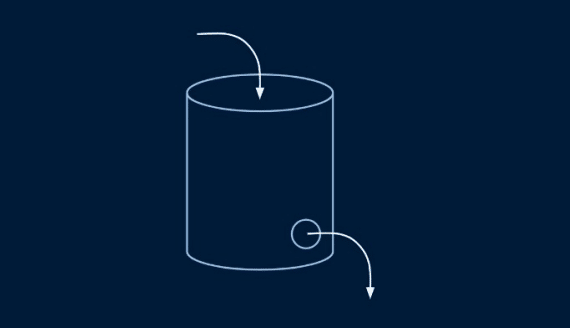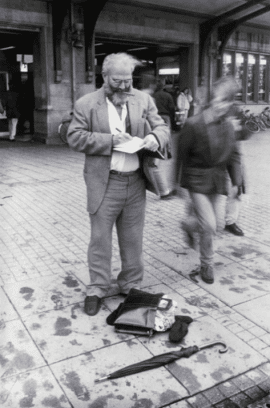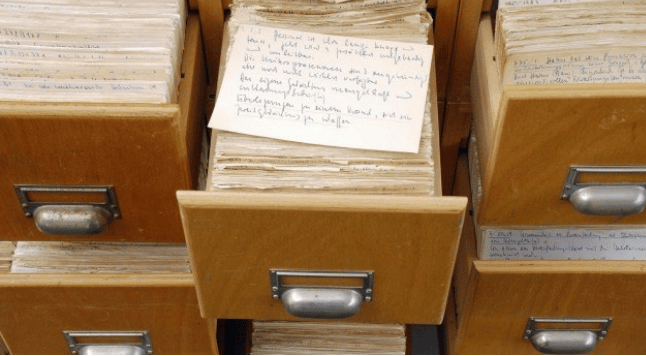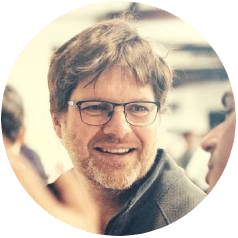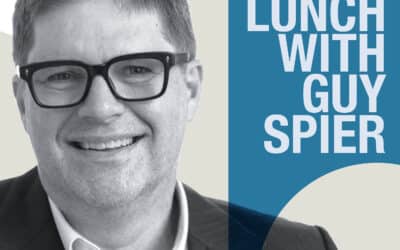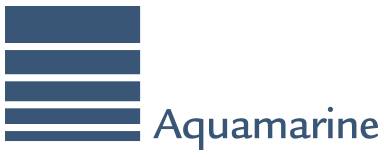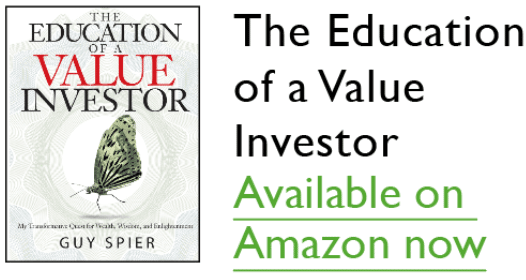The Internet Messed with my Research skills. This is how I got them back.
My relationship with the Internet is love-hate. The part of me that’s curious and inquisitive loves it. Without it, I could not have moved so easily from New York to Zurich. The Internet made it a seamless and uneventful transition.
But the Internet is also confounding. I get so frustrated at how it can completely divert my attention from the task at hand. This is a particular problem when it comes to doing investment research. No doubt, it’s an amazing tool, and I want to do the best possible job as an analyst. But that’s hard if I can’t side-step all the distractions.
I am certainly not alone. There is plenty of writing that grapples with this topic1. And although that has helped, I have often felt despondent. Because despite all the good insights and advice, the Internet – or the algorithms that power the Internet have been winning.
It was not always this way. Thirty-five years ago, as a university student. Before the Internet existed, my only tools were pen and notepaper. I would take these to the various tutorials, seminars, lectures and libraries where I learned and grew as a person.
But so much of this went away with the Internet. A lot of material went online, so I took to reading on a
screen. But the problem was that it was too easy to follow a hyperlink or to jump to another tab. So I preferred to print things out and take notes with a pen. But that did not help all that much either – because I’d find myself drawn back to the computer, to look something up or to read a related item. And so I would inevitably get drawn into some unrelated rabbit-hole
I loved the Internet for all its excellent benefits. But I hated the nasty side effects. Also, the more I used it, the more I felt out of control. During the covid lockdown, I reached a breakthrough – thanks to some extraordinary teachers that I discovered on the web2. The result is that I feel far more in control and can approach the online world – and my investment research – with far more purpose.
1Amongst my favorites are: Atul Gawande, The Checklist Manifesto., Cal Newport, Deep Work. And David Allen, Getting Things Done: The Art of Stress-Free Productivity.
2Tiago Forte, “Building a Second Brain”; Anne Laure Le Cunff, “About Ness Labs – Master Your Mind”; Shu Omi, @shuomi3; David Perell, “@david_perell”; Matthew Kobach, “Matthew Kobach (@mkobach).”
Knowledge Management in a New Era
What I learned can be boiled down to four principles:
- Curator’s Mindset
- Capture Habit
- Review
- Elaboration
1The Curator’s Mindset
This is a mental shift that goes to the root of the challenge: Who’s in charge here? Is it us humans, or the algorithm in the machine?
If I’m scrolling down my Instagram or my YouTube feed, then it’s certainly the algorithm – because it decides what to show me. This is far worse than, for example, mindlessly scrolling through endless cable TV channels. At least they came in no particular order. So in some sense, we were exposed to the common culture bubble. But if it’s Instagram or YouTube, we have no control over what we will be shown next. Tristan Harris34 and Roger McNamee5 are two highly capable engineers who used to work at Google and Facebook. They have written and talked in public about the intense effort that goes into figuring out how to maximize our attention to their media properties.
But if I make the conscious choice to be my own curator, my mindset shifts. It means that I’m taking charge. I’m no longer going to sit back and just let it wash over me. I don’t think it’s overstated to call it a unilateral personal declaration of internet independence.
In practice, this means that we have to start with a purpose in mind. And because we’re curating, we don’t instantly re-share our finds on social media – hoping for likes. In my case, I now take items of interest and print them out. Or I will capture them using a note-taking app – so that I can read them later. My preferred app is Evernote, but I also use Roam Research and Pinboard. The key aspect of these tools is that they leave me in control. Some clipping apps don’t do that, and I’ve learned to be wary. Apps like Pocket, Flipboard, or Pinterest are certainly useful for clipping and curating, but they are also sort of Trojan horse. They send information on our browsing back to their servers which they can then use is to recommend things: “If you clipped this, then let us show you that.” So if we use the wrong apps, we risk putting an algorithm back in charge of our attention.
This curator’s mindset has also changed the way I read in the offline world. To the extent that I can, I will tear articles out of newspapers, magazines and even books – even if I’ve read them once – so that I can re-read them at the right moment. It’s the same principle of curation that’s behind this: Our information environment has gone from sparse to abundant, so mastering it requires a curator’s mindset.
3Tristan Harris, How a Handful of Tech Companies Control Billions of Minds Every Day
4“The Social Dilemma.”
5Roger McNamee, “Zucked – Waking Up to the Facebook Catastrophe.”
Knowledge Management in a New Era
Curating is the first step in our no longer being just spectators. Rather, we become like Theodore Roosevelt’s The Man in the Arena6 – striving valiantly to achieve our goal.
This does not mean that I can’t switch off and meander. Just that this should be a conscious choice – ideally with limits so that it does not become endless.
2The Capture habit
Once I’ve curated something, the next thing is to capture the salient bits as soon as possible. Many of us have this conceited idea that we can keep things in our minds for a while. That we have good working memory. But science has debunked that. Our working memory is severely limited. So if we try to hold onto an idea without capturing it, we are most likely to forget it. And in the meantime, that thought will take up valuable
brain resources that could have been, used for something else., In the past, I would get hung up about how to capture. Most often, I did not have a pen and paper, so I failed to capture at all. And getting that thought back after that fail was an iffy proposition at best. Anne-Laure Le Cunff is an online knowledge management and creativity expert from whom I’ve been learning. She has this simple image of what happens if we fail to capture (see figure 1). It’s not pretty.
1 Anne-Laure Le Cunff on what happens if we don’t capture
6Theodore Roosevelt, “The Man in the Arena.”
Knowledge Management in a New Era
2. Oliver Sacks Captures a fleeting note at Colombia University
Another hero of mine is Oliver Sacks7 – who was a polymath Professor of Psychology at Columbia University. He wrote “The need to think on paper is not confined to notebooks. It spreadsonto the backs of envelopes, menus, whatever scraps of paper are at hand.”8When it comes to deciding what to capture, it’s essential to use our instincts. We may not know or understand why we have a particular thought, why we are being drawn to something. But that should not be a reason not to capture. We can figure all that out later. So I now also use whatever tool is available: I’ll write in my notebook, in the margin of my book or use a Post-It note. I’ll also
highlight on my Kindle, write or record using my iPhone, or clip using Evernote, or Pinboard. The key here is to reduce any possible friction to a minimum. Yet another one of my mentors in knowledge management is Soenke Ahrens9, who wrote an excellent book on how to take smart notes. He calls these sorts of notes “fleeting notes” – and distinguishes them from permanent notes. Another expert in the field of knowledge management, Tiago Forte10, runs an online course called “Building a Second Brain”. That’s a perfect description of what we are doing when we capture a thought. It’s the raw material for our second brain. The first building block for a thinking tool that sits outside of ourselves.
3.Review
This is the next step.
Because if we don’t go back to digest what we captured, we will not achieve much with our thinking. This review can now take place in a highly enriched environment. Because all the captured materials will have been captured for a reason. Now it’s possible to discern patterns.
7Oliver Sacks, On the Move; James Clear, “Book Summary.”
8Maria Popova, “Inside Oliver Sacks’s Creative Process.”
9Soenke Ahrens, “How to Take Smart Notes: One Simple Technique to Boost Writing, Learning and Thinking.”
10Tiago Forte, “Building a Second Brain.”
Knowledge Management in a New Era
The master of this was Niklas Luhmann11 who is the main subject of Soenke Ahrens’ book. Luhmann was a highly prolific German Professor of Sociology who published more than 70 books and nearly 400 scholarly articles. Integral to his scholarship was his system of Zettelkasten – or 3×5 notecards12. He amassed more than 90,000 in his lifetime. As with Tiago Forte’s idea of a “Second Brain”, Luhmann considered it his “thinking partner.”
3 Luhmann’s Zettelkasten
Review starts with examining each item that has been captured and asking:
- Why is this relevant?
- In what context might it be relevant in the future?
- Where would it be useful?
- How does it relate to what I already know?
You may already know of Charlie Munger. He is a close friend to Warren Buffett and is both brilliant and wise.
In his talk on 24 Human Misjudgments, 13 he talks about the need to array our thoughts on a “Latticework of Mental Models”. He also tells his audience that they need to do the work themselves. That seems to me to be the point of review. It’s something that we have to do ourselves. It’s also the reason why another person’s set of lecture notes are useless: What’s written on the paper is useless – it’s the mental work that went into creating them that’s valuable.
Thus when we review our fleeting notes what we are actually doing is updating our mental latticeworks. It’s a way of updating our mental maps with new evidence from the territory.
4Elaboration and Creation
The final step is to create something new – using what we have learned. In his talk, Charlie Munger refers to a principle used in medical education of “see one, do one, teach one” which references the same idea.
In my case, this might happen over a dinner conversation with friends and family where I excitedly explain something that I learned. And Niklas Luhmann would write a permanent note for his Zettelkasten. Or it could involve teaching the subject, or writing a teaching plan, an essay, or a memo. One could also record a podcast or create a video-log. Another method that I find particularly intriguing is the tweet thread, or “tweetstorm”. To do that I would break up what I have to say into a series of tweets – all threaded together. Each of these tweets stands on its own, and so can be reacted to individually – allowing for individualized feedback. These
11“Niklas Luhmann.”
12Sascha Fast and Christian Tietze, “Zettelkasten Knowledge and Info Management”; “Zettelkasten.”
13“24 Standard Causes of Human Misjudgment (Cognitive Biases) – My Virtual Reading Room.”
Knowledge Management in a New Era
atter methods can be considered as examples of “learning in public”. To the extent that I do learn in public, this can also be considered as a kind of investment in my own social capital14.
These insights have had an enormous impact on how I structure my work, and I feel far more organized. Whether I’m online, or with printed materials I write notes to my future self and then put the item away for my “future self to review”.
Why this seems to work
The reason why this seems to work is that it aligns with the way our brain evolved. Consider that we need to go back 5-6 million years to get to a common ancestor with chimpanzees. Meanwhile, the bronze age started less than 10,000 years ago, and computers have only been around for a couple of decades. So most of our evolution happened well before all of the technologies that we use today.
I’m no evolutionary biologist – indeed, all of my knowledge on this topic comes from just two books – by Yuval Hariri15 and Jared Diamond16. But it stands to reason that most of our mental processes evolved to suit our hunter-gatherer, evolutionary past – where our only tools were sticks, stones and perhaps fire.
Take, for example, working memory. Scientists have found that it can’t store much,17. So when we capture something in a fleeting note, that is a smart way of dealing with the limitations of working memory. And if we want to commit something to long term memory, we need to repeat it. When we review our fleeting notes, that is the first act of repeating something. And the act of re-reviewing is a form of spaced repetition1819. Experts also know that if we want to learn something really well, we need to elaborate it – to or ourselves at least, if not to others. Re-sharing our work in some form is the act of doing that.
As a species, we have a well developed visual and spatial system. To the extent that we can engage those systems today, we can vastly improve our mental functioning. A few years ago Joshua Foer20 wrote a book about how he uses memory palaces. Foer explains that our brains are visual and spatial. This is not surprising given that we spent most of our evolutionary history in jungle type environments. We remember things better when we have visual hooks to hang them on.
As I have started to incorporate this into the way I work, my physical and virtual environments have become more usefully abundant. Because I keep thinking of what my future self would want to see when it comes across something for a second time.
14Almuqrin et al., “The Explanatory Power of Social Capital in Determining Knowledge Sharing in Higher Education: A Case from Saudi Arabia.”
155 Harari, Sapiens
16Diamond, Guns, Germs and Steel
17“Short-Term Memory.”
18“Spaced Repetition.”
19Paul Smolen, Yili Zhang, and John H. Byrne, “The Right Time to Learn.”
20Joshua Foer, Moonwalking with Einstein.
Knowledge Management in a New Era
A book, an article or a printout is no longer just that. It’s a reminder of the author and their story. Notes in the margin remind me of what my thoughts were on the first reading.
All this has helped me to be far more organized. Because the task of organizing the annual reports, books and papers in and around my desk is no longer done with the goal of being a neat freak. Rather, by organizing my things, I’m organizing my thoughts. In deciding what’s a higher priority and what’s a lower priority. What I want to review and when. In organizing, I’m engaging in the exercise of spaced repetition.
Technology and other thoughts.
I have not talked much about what particular technology to use. That is because the principles are rooted in our biology, not in the technology. They should be indifferent to technology – which in any case is constantly changing. If we work in a way that is consistent with our biology, then we can be neutral on technology and simply select what fits best with the principles.
In other words, we should not have to choose between the computer, the iPhone or the notepad and pen. It’s all of them. Poets in the time of Homer only had the option to memorize and speak. That was all that was available. Today we have far more choice. But let’s not forget that the technology is just a tool to explore and think about our world. No different to the stones, sticks and bones of our hunter-gatherer ancestors, the pen and papyrus of a later world, or the smartphone of today. Tiago Forte, for example, is particularly good at teaching his students to use tools like Evernote, Roam Research and Notion. And Soenke Ahrens is the best when it comes to Zettelkasten.
And while technology is continually changing, the thinking structures in our brains are not. Whatever new or old technology we use needs to relate back to the basic mental processes that we have evolved with. We have to work in alignment with them, not against them.
So it’s also okay to try new technology and then stop using it – so long as we review and reintegrate what was captured.
My experience in activating my visual and spatial memory has been particularly exciting for me – as I feel that I am using my brain the way it wants to be used and that I’m far more effective.
So I’ve taken Joshua Foer’s advice on memory palaces one step further. Rather than create artificial memory palaces, I try to see the real world as one great big memory place. That’s my goal: People. Places. Objects Street names. Place-Names. They all become hooks on which to hang knowledge and ideas.
Instead of using some meaningless mnemonic to remember something about someone, I would rather take it one step further. For example, here in Zurich, I modified my cycling route to take in the graveyard where James Joyce is buried and memorialized. I now enjoy Zurich because of that. And I enjoy James Joyce’s Ulysses more because I know that was written in Zurich.
Similarly, visitors to Omaha are not wrong to visit Warren Buffett’s home or his office at Kiewit Plaza. When I think of some of the people I know through the Berkshire meeting, I remember them better when I recall the person in the context in the specific place in Omaha I met them.
Knowledge Management in a New Era
So my world has become a far more interesting and memorable place – where I see interrelationships far more clearly.
One final thought: Does all of this have enormous implications for investment research? Absolutely. I’m taking in more relevant information and insights, and I’m storing it better. And I’ve become more systematic in how I review investment opportunities.
Conclusion.
When it comes to ancient technologies – like fire and stones, our ancestors were able to co-evolve with them: our DNA made the adaptation. Today the rate of change is too great. Our DNA can’t keep up. Neither can our minds – which evolved to operate in an environment very different from what we have today.
f we are to thrive, we need to use insights from our evolutionary psychology and adapt how we use technology to how our brains actually work.
During the lockdown, I stumbled across a set of four principles: curate, capture, review and elaborate – which enabled me to do just that.
As a result, my work has become more manageable, and I am more productive. Perhaps all this will work for you if you try it. Or perhaps you are further along the learning curve than I am.
Either way, feel free to write and tell me. You can email me: gspier[at]aquamarinefund.com Or you can
tweet me @gspier
Knowledge Management in a New Era
Resources and References
Some of my tools
- 3×5 notecards
- Evernote
- Feedly
- Moleskin
- Notion
- Readwise
- Roam Research
- Simplenote
- Zotero
Knowledge Management in a New Era
“24 Standard Causes of Human Misjudgment (Cognitive Biases) – My Virtual Reading Room.” Accessed
October 30, 2020.https://sites.google.com/site/myvirtualstudyroom/home/24-standard-causesof-human-misjudgment
Almuqrin, Abdullah, Justin Zhang, Aljawharah Alzamil, Ibrahim Mutambik, and Abdullah Alhabeeb. “The
Explanatory Power of Social Capital in Determining Knowledge Sharing in Higher Education: A
Case from Saudi Arabia.” Malaysian Journal of Library and Information Science 29 (December 24,
2020): 71–90.
Anne Laure Le Cunff. “About Ness Labs – Master Your Mind.” Blog. Ness Labs. Accessed October 26, 2020https://nesslabs.com/about
Atul Gawande. The Checklist Manifesto: How to Get Things Right.Main Edition. London: Profile, 2011.
Cal Newport. Deep Work: Rules for Focused Success in a Distracted World. London: Piatkus, 2016.
David Allen. Getting Things Done: The Art of Stress-Free Productivity, 2015.
https://www.amazon.co.uk/Getting-Things-Done-Stress-free-Productivity/dp/0349408947
David Perell. “David Perell.” David Perell, n.d.
Diamond, Jared. Guns, Germs and Steel: A Short History of Everybody for the Last 13,000 Years. New Ed
edition. London: Vintage, 1998.
Harari, Yuval Noah. Sapiens: A Brief History of Humankind. London: Harvill Secker, 2014.
James Clear. “Book Summary: On the Move: A Life by Oliver Sacks.” James Clear (blog). Accessed October27, 2020.https://jamesclear.com/book-summaries/on-the-move
Joshua Foer. Moonwalking with Einstein: The Art and Science of Remembering Everything. London:
Penguin, 2012.
Maria Popova. “Inside Oliver Sacks’s Creative Process: The Beloved Writer’s Never-Before-Seen
Manuscripts, Brainstorm Sheets, and Notes on Writing, Creativity, and the Brain.” Brain Pickings
(blog), March 7, 2017. https://www.brainpickings.org/2017/03/07/oliver-sacks-notebooks/
Matthew Kobach. “Matthew Kobach (@mkobach).” Matthew Kobach. Accessed October 26, 2020
https://twitter.com/mkobach
“Niklas Luhmann.” In Wikipedia, September 5, 2020.
https://en.wikipedia.org/w/index.php?title=Niklas_Luhmann&oldid=976819107
Oliver Sacks. On the Move: A Life. Large Print Edition. Thorndike Press, 2015.
Knowledge Management in a New Era
Paul Smolen, Yili Zhang, and John H. Byrne. “The Right Time to Learn: Mechanisms and Optimization of Spaced Learning.” Nature Reviews. Neuroscience 17, no. 2 (February 2016): 77–88. https://www.nature.com/articles/nrn.2015.18
Roger McNamee. “Zucked – Waking Up to the Facebook Catastrophe.” Accessed October 27, 2020. https://www.zuckedbook.com/
Sascha Fast and Christian Tietze. “Zettelkasten Knowledge and Info Management.” Accessed October 27, 2020.https://zettelkasten.de/
“Short-Term Memory.” In Wikipedia, October 6, 2020.https://en.wikipedia.org/w/index.php?title=Short-term_memory&oldid=982222379
Shu Omi. “Shu Omi.” Blog. Shu Omi. Accessed October 27, 2020.https://www.shuomi.me/
Soenke Ahrens. “How to Take Smart Notes: One Simple Technique to Boost Writing, Learning and Thinking,”https://www.amazon.co.uk/How-Take-Smart-Notes-Nonfiction-ebook/dp/B06WVYW33Y
“Spaced Repetition.” In Wikipedia, October 26, 2020.https://en.wikipedia.org/w/index.php?title=Spaced_repetition&oldid=985533554
Netflix. “The Social Dilemma,” 2020.https://www.netflix.com/in/title/81254224
Theodore Roosevelt. “The Man in the Arena.” Blog. Maria Popova’s Brain Pickings. Accessed October 27, 2020. https://explore.themarginalian.org/post/173489247813/it-is-not-the-critic-who-counts-not-the-man-who
Tiago Forte. “Building a Second Brain.” Online Course. Building a Second Brain. Accessed October 27,
2020.https://www.buildingasecondbrain.com/
Tristan Harris. How a Handful of Tech Companies Control Billions of Minds Every Day. TED Talks.
Vancouver. Accessed October 27, 2020. https://www.ted.com/talks/tristan_harris_how_a_handful_of_tech_companies_control_billions_o
“Zettelkasten.” In Wikipedia, October 27, 2020.https://en.wikipedia.org/w/index.php?title=Zettelkasten&oldid=98577

